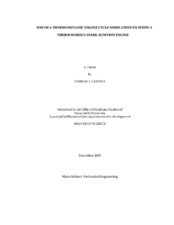| dc.contributor.advisor | Caton, Jerald A. | |
| dc.creator | Lawand, Vaibhav | |
| dc.date.accessioned | 2010-07-15T00:14:51Z | |
| dc.date.accessioned | 2010-07-23T21:45:56Z | |
| dc.date.available | 2010-07-15T00:14:51Z | |
| dc.date.available | 2010-07-23T21:45:56Z | |
| dc.date.created | 2009-12 | |
| dc.date.issued | 2010-07-14 | |
| dc.date.submitted | December 2009 | |
| dc.identifier.uri | https://hdl.handle.net/1969.1/ETD-TAMU-2009-12-7312 | |
| dc.description.abstract | The second law analysis is a powerful tool for assessing the performance of engines
and has been employed for few decades now. Turbocharged diesel engines have been
explored in much detail with the help of second law analyses. There is also a need to
examine the turbocharged spark-ignition engines in greater detail using second law
analyses as they are gaining popularity in high performance and conventional
automobiles as well. A thermodynamic simulation was developed in order to
investigate the effects of turbocharging on spark-ignition engines from second law
perspective. The exergy values associated with the components of the turbocharger
along with the engine components were quantified as a percentage of fuel exergy. The
exergy balance values indicated that turbocharger does not add considerably to the
overall irreversibilities and combustion irreversibility is still the major source of exergy
destruction. A comprehensive parametric investigation was also performed to
investigate the effects of compression ratio, intercooler effectiveness, etc. for the
turbocharged spark-ignition engine over the entire load and speed range. The
simulation studies helped in understanding the behavior of turbocharged sparkignition
engine with these parameters.
A simulation study was also performed to compare the turbocharged engine with the
naturally aspirated spark-ignition engine. This study examined the engines for
operating parameters like bmep and bsfc over the entire speed range and revealed
that turbocharging offers higher bmep and lower bsfc values for most of the operating
range. In an additional study, these engines were analyzed for the brake thermal efficiency values at part load. The results indicated that turbocharging offers
marginally higher brake thermal efficiency at part loads. | en |
| dc.format.mimetype | application/pdf | |
| dc.language.iso | eng | |
| dc.subject | thermodynamic engine cycle simulation | en |
| dc.title | Use of a Thermodynamic Engine Cycle Simulation to Study a Turbocharged Spark-ignition Engine | en |
| dc.type | Thesis | en |
| thesis.degree.department | Mechanical Engineering | en |
| thesis.degree.discipline | Mechanical Engineering | en |
| thesis.degree.grantor | Texas A&M University | en |
| thesis.degree.name | Master of Science | en |
| thesis.degree.level | Masters | en |
| dc.contributor.committeeMember | Hassan, Yassin A. | |
| dc.contributor.committeeMember | Jacobs, Timothy J. | |
| dc.type.genre | thesis | en |
| dc.type.material | text | en |


